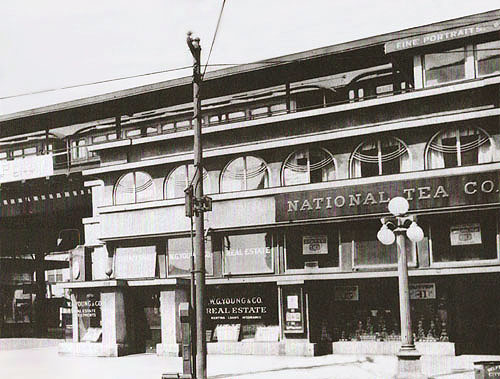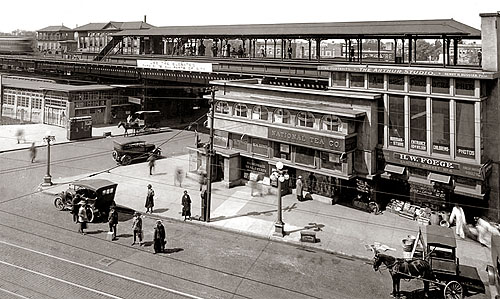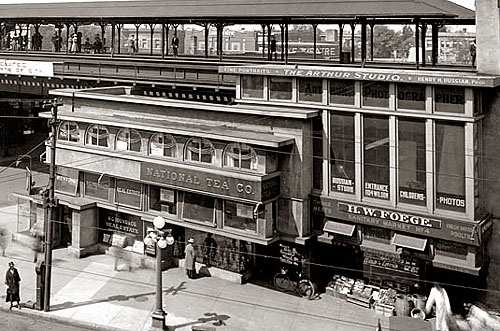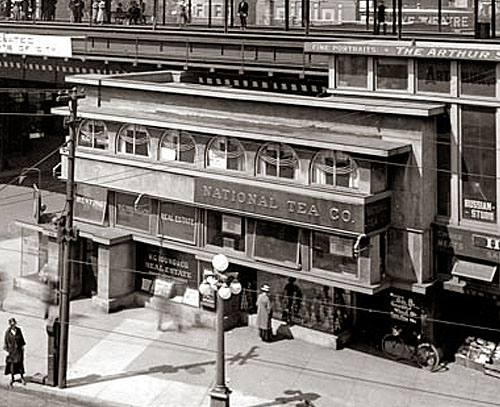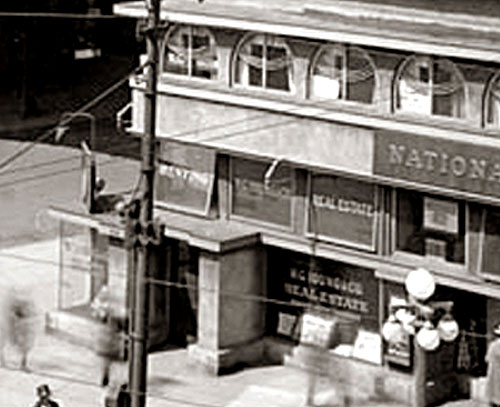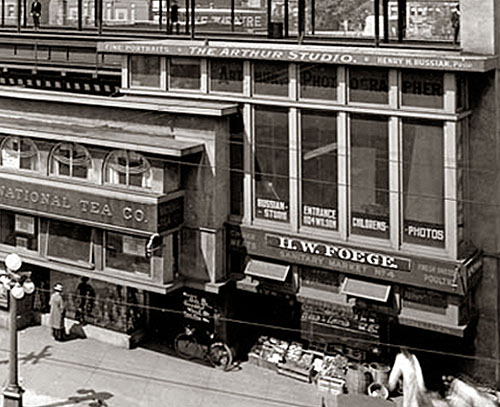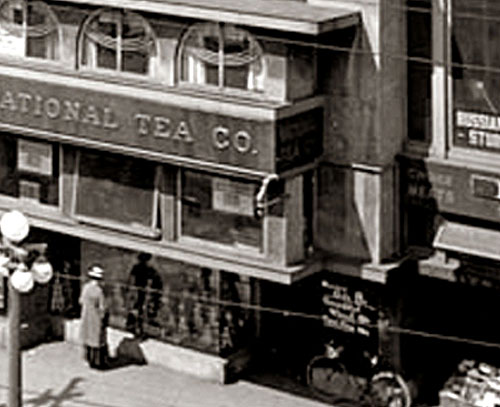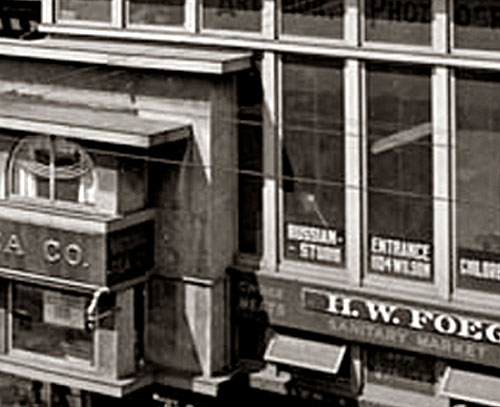- Wright Studies
Peter C. Stohr Arcade Building, Chicago, IL (1909) (S.162)
Historic Photographs of the Stohr Arcade Building
Not only was it a triangular piece of property, but a majority of the property was situated under the elevated tracks. Wright had to incorporate the steel girders from the tracks above. He took advantage of the Southeast corner which came out from under the tracks, and designed a three story section. The length of the building consisted of a row of shops and offices that opened up into a Mezzanine. Hence, the Stohr Arcade. The second floor design, is almost reminiscent of the Gale Residence (1904, Oak Park, S.098), and the third floor is consistent with Wright’s Oak Park Prairie style designs. The flat roof was reinforced concrete. The chimney extends twelve feet above the roof line. Wright designed large geometric vases placed atop integrated pedestals, and continuous window boxes for planting. He also designed cube and sphere lighting fixtures that topped integrated pedestals at the corner entrance. There exists no photographic evidence that the vases were ever added, but a form of the light fixtures were installed above the Southeast corner on the roof of the first level as designed.
Stohr Arcade Building Circa 1917
Courtesy of the Chicago Historical Society
Viewed from the Northeast. A form of the light fixture Wright designed is visible above the Southeast corner on the roof of the first level. Large windows at the top of the first floor allow light into the interior and swing open at the bottom allowing air to naturally cool the building. The second floor window design consisting of large arched curves which were unique only in this Wright building.
Courtesy of the Krambles-Peterson Archives
Viewed from the Northeast. On the far left, the Southeast corner of the street level, the mitered glass corner is visible. This may be the first example of Wright's use of mitered corners. The street level has at lease two visible examples. The large sets of vertical windows on the right cover two floors. The large vertical plate glass windows are nearly twelve feet high. On the far left, the Southeast corner of the street level, the mitered glass corner is visible. The second is in the center, just to the right of the gentleman window shopping. This may be the first example of Wright's use of mitered corners. A form of the light fixture Wright designed is visible above the Southeast corner on the roof of the first level. The large sets of vertical windows on the right cover two floors. The large vertical plate glass windows are nearly twelve feet high.
On the far left, the Southeast corner of the street level, the mitered glass corner is visible. The second is in the center, just to the right of the gentleman window shopping. This may be the first example of Wright's use of mitered corners. A form of the light fixture Wright designed is visible above the Southeast corner on the roof of the first level. Large windows at the top of the first floor allow light into the interior and swing open at the bottom allowing air to naturally cool the building. The second floor window design consisting of large arched curves which were unique only in this Wright building. On the far left, the Southeast corner of the street level, the mitered glass corner is visible. This may be the first example of Wright's use of mitered corners. A form of the light fixture Wright designed is visible above the Southeast corner on the roof of the first level. Large windows at the top of the first floor allow light into the interior and swing open at the bottom allowing air to naturally cool the building. The second floor window design consisting of large arched curves which were unique only in this Wright building.
A mitered glass corner is visible just to the right of the gentleman window shopping. This may be the first example of Wright's use of mitered corners. Large windows at the top of the first floor allow light into the interior and swing open at the bottom allowing air to naturally cool the building. The second floor window design consisting of large arched curves which were unique only in this Wright building. The large sets of vertical windows on the right cover two floors. The large vertical plate glass windows are nearly twelve feet high. A mitered glass corner is visible just to the right of the gentleman window shopping. This may be the first example of Wright's use of mitered corners. Large windows at the top of the first floor allow light into the interior and swing open at the bottom allowing air to naturally cool the building. The second floor window design consisting of large arched curves which were unique only in this Wright building. The large sets of vertical windows on the right cover two floors. The second floor intersects the plate glass. The large vertical plate glass windows are nearly twelve feet high.
Text by Douglas M. Steiner, Copyright 2009 BACK HOME ARTIFACTS AUDIO BOOKS PERIODICALS PHOTOS POSTCARDS POSTERS STAMPS STUDIES ASSISTING ABOUT SEARCH
©Copyright 2009
